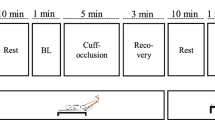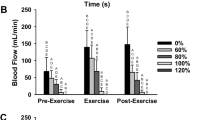Abstract
The time course of muscle oxygen desaturation (StO2 kinetics) following exercise onset reflects the dynamic interaction between muscle blood flow and muscle oxygen consumption. In patients with peripheral arterial disease (PAD), muscle StO2 kinetics are slowed during walking exercise; potentially reflecting altered muscle oxygen consumption relative to blood flow. This study evaluated whether StO2 kinetics measured using near infrared spectroscopy (NIRS) would be slowed in PAD during low work rate calf exercise compared with healthy subjects under conditions in which blood flow did not differ. Eight subjects with PAD and eight controls performed 3 min of calf exercise at 5, 10, 30, and 50% of maximal voluntary contraction (MVC). Calf blood flow responses were measured by plethysmography. Power outputs were similar between groups for all work rates. In PAD, the time constants of StO2 kinetics were significantly slower than controls during 5% MVC (13.5 ± 1.7 vs. 6.9 ± 1.2 s, P < 0.05) and 10% MVC work rates (14.5 ± 2.7 vs. 6.8 ± 1.1 s, P < 0.05). Blood flow assessed when exercise was interrupted after 30 s did not differ between PAD and control subjects at these work rates. In contrast, the StO2 time constants were not different between groups during 30 and 50% MVC work rates, where blood flow responses in PAD subjects were lower as compared with controls. Thus in PAD, the slowed StO2 kinetic responses under conditions of unimpaired calf blood flow reflect slowed muscle oxygen consumption in PAD skeletal muscle during low work rate plantar flexion exercise as compared with healthy skeletal muscle.



Similar content being viewed by others
References
Barker GA, Green S, Green AA, Walker PJ (2004) Walking performance, oxygen uptake kinetics and resting muscle pyruvate dehydrogenase complex activity in peripheral arterial disease Clin. Sci (Lond) 106:241–249
Bauer TA, Regensteiner JG, Brass EP, Hiatt WR (1999) Oxygen uptake kinetics during exercise are slowed in patients with peripheral arterial disease. J Appl Physiol 87:809–816
Bauer TA, Brass EP, Hiatt WR (2004a) Impaired muscle oxygen use at onset of exercise in peripheral arterial disease. J Vasc Surg 40:488–493
Bauer TA, Brass EP, Nehler M, Barstow TJ, Hiatt WR (2004b) Pulmonary VO2 dynamics during treadmill and arm exercise in peripheral arterial disease. J Appl Physiol 97:627–634
Bernink PJ, Lubbers J, Barendsen GJ, van den Berg J (1982) Blood flow in the calf during and after exercise: measurements with Doppler ultrasound and venous occlusion plethysmography in healthy subjects and in patients with arterial occlusive disease. Angiology 33:146–160
Brass EP, Hiatt WR, Gardner AW, Hoppel CL (2001) Decreased NADH dehydrogenase and ubiquinol-cytochrome c oxidoreductase in peripheral arterial disease. Am J Physiol 280:H603–H609
Egana M, Green S (2005) Effect of body tilt on calf muscle performance and blood flow in humans. J Appl Physiol 98:2249–2258
Esaki K, Hamaoka T, Radegran G, Boushel R, Hansen J, Katsumura T, Haga S, Mizuno M (2005) Association between regional quadriceps oxygenation and blood oxygen saturation during normoxic one-legged dynamic knee extension. Eur J Appl Physiol 95:361–370
Ferreira LF, Poole DC, Barstow TJ (2005) Muscle blood flow–O(2) uptake interaction and their relation to on-exercise dynamics of O(2) exchange. Respir Physiol Neurobiol 147:91–103
Green S (2002) Haemodynamic limitations and exercise performance in peripheral arterial disease. Clin Physiol Funct Imaging 22:81–91
Greenhaff PL, Campbell-O’Sullivan SP, Constantin-Teodosiu D, Poucher SM, Roberts PA, Timmons JA (2002) An acetyl group deficit limits mitochondrial ATP production at the onset of exercise. Biochem Soc Trans 30:275–280
Kemp GJ, Roberts N, Bimson WE, Bakran A, Harris PL, Gilling-Smith GL, Brennan J, Rankin A, Frostick SP (2001) Mitochondrial function and oxygen supply in normal and in chronically ischemic muscle: a combined 31P magnetic resonance spectroscopy and near infrared spectroscopy study in vivo. J Vasc Surg 34:1103–1110
Kemp GJ, Roberts N, Bimson WE, Bakran A, Frostick SP (2002) Muscle oxygenation and ATP turnover when blood flow is impaired by vascular disease. Mol Biol Rep 29:187–191
Lesnefsky EJ, Hoppel CL (2003) Ischemia-reperfusion injury in the aged heart: role of mitochondria. Arch Biochem Biophys 420:287–297
MacDonald MJ, Tarnopolsky MA, Green HJ, Hughson RL (1999) Comparison of femoral blood gases and muscle near-infrared spectroscopy at exercise onset in humans. J Appl Physiol 86:687–693
Mancini DM, Bolinger L, Li H, Kendrick K, Chance B, Wilson JR (1994) Validation of near-infrared spectroscopy in humans. J Appl Physiol 77:2740–2747
Marcinek DJ, Ciesielski WA, Conley KE, Schenkman KA (2003) Oxygen regulation and limitation to cellular respiration in mouse skeletal muscle in vivo. Am J Physiol Heart Circ Physiol 285:H1900–H1908
Myers DE, Andersen LD, Seifert RP, Ortner JP, Cooper CE, Beilman GJ, Mowlem JD (2005) Noninvasive method for measuring local hemoglobin oxygen saturation in tissue using wide gap second derivative near-infrared spectroscopy. J Biomed Opt 10:034017-1–034017-18
Pernow B, Zetterquist S (1968) Metabolic evaluation of the leg blood flow in claudicating patients with arterial obstructions at different levels. Scand J Clin Lab Invest 21:277–287
Pernow B, Saltin B, Wahren J, Cronestrand R, Ekestroom S (1975) Leg blood flow and muscle metabolism in occlusive arterial disease of the leg before and after reconstructive surgery. Clin Sci Mol Med 49:265–275
Pipinos II, Sharov VG, Shepard AD, Anagnostopoulos PV, Katsamouris A, Todor A, Filis KA, Sabbah HN (2003) Abnormal mitochondrial respiration in skeletal muscle in patients with peripheral arterial disease. J Vasc Surg 38:827–832
Pipinos II, Judge AR, Zhu Z, Selsby JT, Swanson SA, Johanning JM, Baxter BT, Lynch TG, Dodd SL (2006) Mitochondrial defects and oxidative damage in patients with peripheral arterial disease. Free Radic Biol Med 41:262–269
Quaresima V, Homma S, Azuma K, Shimizu S, Chiarotti F, Ferrari M, Kagaya A (2001) Calf and shin muscle oxygenation patterns and femoral artery blood flow during dynamic plantar flexion exercise in humans. Eur J Appl Physiol 84:387–394
Seiyama A, Hazeki O, Tamura M (1988) Noninvasive quantitative analysis of blood oxygenation in rat skeletal muscle. J Biochem (Tokyo) 103:419–424
Sorlie D, Myhre K (1978) Lower leg blood flow in intermittent claudication. Scand J Clin Lab Invest 38:171–179
Tran TK, Sailasuta N, Kreutzer U, Hurd R, Chung Y, Mole P, Kuno S, Jue T (1999) Comparative analysis of NMR and NIRS measurements of intracellular PO2 in human skeletal muscle. Am J Physiol 276:R1682–R1690
van Beekvelt MC, Borghuis MS, van Engelen BG, Wevers RA, Colier WN (2001) Adipose tissue thickness affects in vivo quantitative near-IR spectroscopy in human skeletal muscle. Clin Sci (Lond) 101:21–28
Acknowledgments
This study was supported by the General Clinical Research Center of University of Colorado Hospital (NIH MO1 #RR000051) and Hutchinson Technology, Inc.
Author information
Authors and Affiliations
Corresponding author
Rights and permissions
About this article
Cite this article
Bauer, T.A., Brass, E.P., Barstow, T.J. et al. Skeletal muscle StO2 kinetics are slowed during low work rate calf exercise in peripheral arterial disease. Eur J Appl Physiol 100, 143–151 (2007). https://doi.org/10.1007/s00421-007-0412-0
Accepted:
Published:
Issue Date:
DOI: https://doi.org/10.1007/s00421-007-0412-0




